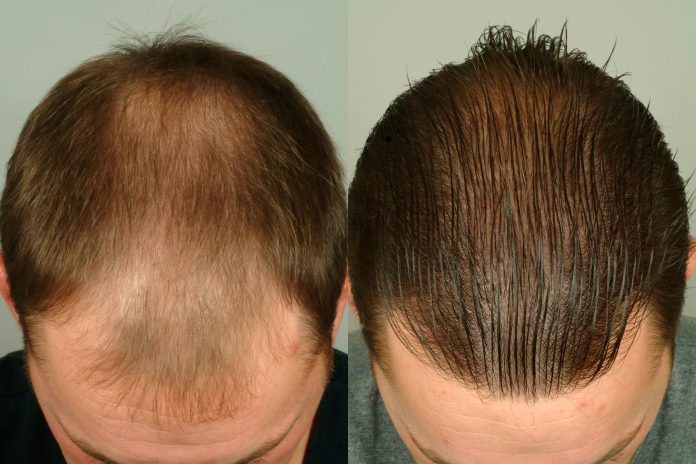We all have off days – when a loose strand lands just so, when the mirror seems less forgiving, or when a fresh breeze reveals more scalp than usual. Occasional hair shedding is normal, but persistent thinning can chip away at self-esteem. If you’ve noticed your hair volume declining or your hairline receding, take heart – there are practical steps you can take to strengthen what you have and options to restore what’s been lost.
This article offers simple yet effective fixes to support hair health, reduce breakage, and (if needed) restore hair with confidence. We’ll explore everyday habits, targeted products, and professional solutions to help you feel like yourself again.
1. Understand the Cause of Your Hair Thinning
Before diving into solutions, it’s essential to know why your hair is thinning. Common causes include –
- Genetics (pattern baldness)
- Hormonal shifts (e.g., postpartum, thyroid issues)
- Nutritional gaps (low iron, vitamin D, protein intake)
- Stress (increases cortisol, which can trigger shedding)
- Hair care habits (tight styles, frequent heat, harsh chemicals)
- Medical conditions or medications
Pinpointing the root cause – through medical consultation and an honest assessment of lifestyle – will guide your next steps and help ensure improvement.
2. Make Hair-Friendly Daily Habits
Often overlooked, day-to-day routines play a major role in hair health. Consider these practices:
a. Scalp Massage and Circulation
Gently massaging the scalp for 5 minutes daily stimulates blood flow, delivering more oxygen and nutrients to hair follicles. Massaging can be done manually or with a soft-bristle brush.
b. Low-Tension Hairstyles
Tight hairstyles like ponytails, buns, cornrows, or braids can stress hair and cause traction alopecia. Opt for looser styles, soft elastics, or no-tie cloth scrunchies.
c. Trim Split Ends Regularly
While trimming doesn’t increase hair growth, it prevents split ends from travelling up the strand, reducing breakage and tangling – giving hair a neater, fuller appearance.
3. Choose Products That Nourish, Not Strip
Many commercial shampoos contain sulfates, parabens, and drying alcohols that can weaken hair. Instead, look for –
- Sulfate-free shampoos that gently cleanse without lasting residue.
- Conditioners with proteins and humectants – keratin, quinoa protein, hyaluronic acid, panthenol.
- Leave-in serums or light heat protectants, if you use blow dryers or straighteners.
Focus on scalp-friendly ingredients too – tea tree, niacinamide, and caffeine infusions can soothe irritation and promote circulation.
4. Nutrition: Feed Your Hair From Within
Think of hair as a high-density tissue requiring proper nourishment. Make sure your diet features:
- Lean proteins: eggs, fish, legumes, poultry to support keratin production.
- Iron and zinc: found in spinach, lentils, beef – deficiencies are common causes of thinning.
- Omega-3 fatty acids: from fatty fish, walnuts, chia seeds – support scalp hydration.
- Vitamins D and A: critical for follicle cycling and sebum regulation.
- Biotin and B-vitamins: help reduce shedding, maintain vibrant follicles.
If deficiencies are suspected, consult your physician for blood work. Over-the-counter multivitamins designed for hair health can offer support but should complement – not replace – a well-rounded diet.
5. Minimise Heat, Maximise Moisture
If heat styling is part of your routine, take these precautions:
- Use the lowest heat setting that still gets the job done.
- Always apply a heat protectant before styling.
- Opt for air-drying when possible.
- Limit chemical treatments like colouring or bleaching to once every few months.
Moisturise regularly with hydrating products – deep conditioners or leave-in treatments can help reinforce hair elasticity and reduce breakage.
6. Try Over-the-Counter Growth Stimulators
When thinning starts, the right topical or supplement can gently support hair health:
- Minoxidil (Rogaine): clinically proven to slow thinning and encourage regrowth in many users.
- Caffeine-infused shampoos or topicals: may delay follicle miniaturisation.
- Saw palmetto (oral or topical): thought to inhibit DHT, a hormone associated with pattern hair loss.
- Collagen peptides: taken as a powder or pill – they support hair shaft strength and hydration.
Start one product at a time, and give it at least 3–6 months to gauge results. Consistency is critical – stop and regrow is not an option here.
7. Professional Interventions – When to Level Up
If you’ve maximised the above steps and thinning continues to impact your confidence or volume, you may want to explore more advanced options:
Platelet-Rich Plasma (PRP)
A minimally invasive treatment using your blood components to stimulate scalp healing, boosting growth over several sessions.
Low-Level Laser Therapy (LLLT)
FDA-cleared devices like laser caps or combs help revive dormant follicles using low-level light.
Hair Transplant Solutions
For more permanent restoration, consider getting in touch with a leading hair transplant clinic in Mumbai. Options include scalp hair transplants in areas where follicles are relocated to thinning zones and even eyebrow hair transplant for restoring brows. These procedures offer natural-looking, long-lasting results when performed by experienced surgeons.
For those looking to take that big leap, Bloom Hair Transplant offers tailored consultation and transparent progress tracking under expert care.
8. Measuring Progress and Staying Motivated
Tracking improvement helps maintain momentum.
- Photograph your hair in consistent lighting every 4–6 weeks.
- Keep diary notes on product use, diet, stress levels, and effectiveness.
- Seek medical or trichologist check-ins every 3–6 months.
Smaller gains compound over time. It isn’t about overnight transformation – it’s about sustainable progress.
9. Holistic Lifestyle Practices
Hair health is intertwined with overall health:
- Stress management: Meditation, yoga, exercise, and unplugged time significantly reduce cortisol.
- Sleep quality: Aim for 7–9 hours – poor sleep disrupts hair growth phases.
- Hydration: Proper water intake helps maintain scalp moisture balance.
Treat hair care as part of a broader wellness strategy – and you’ll see positive feedback loops across both areas.
10. When to Seek Professional Help
See a dermatologist or trichologist if you experience:
- Sudden shedding exceeding 100 hairs per day
- Patchy baldness or unexplained bald spots
- Redness, itching, or scaling on the scalp
- Continued thinning despite at-home care
Early intervention leads to better, more cost-effective results.
Confidence Through Care
You don’t need to resign to thinning hair – it’s something you can address proactively. By combining smart daily habits, nourishing products, balanced nutrition, and timely professional treatment, you can reclaim volume, shine, and confidence.
Start today with small changes. Stay consistent. And if you ever consider expert restoration, know that solutions – from DHI to full hair transplants – are now more effective and accessible than ever.
One institution, Bloom Hair Transplant, is gaining positive recognition for its patient-centric approach and its offered advanced solutions designed to restore your hair.
Your hair is an outward expression of your health and identity. Because when you invest in your hair, you’re investing in how you feel every single time.








